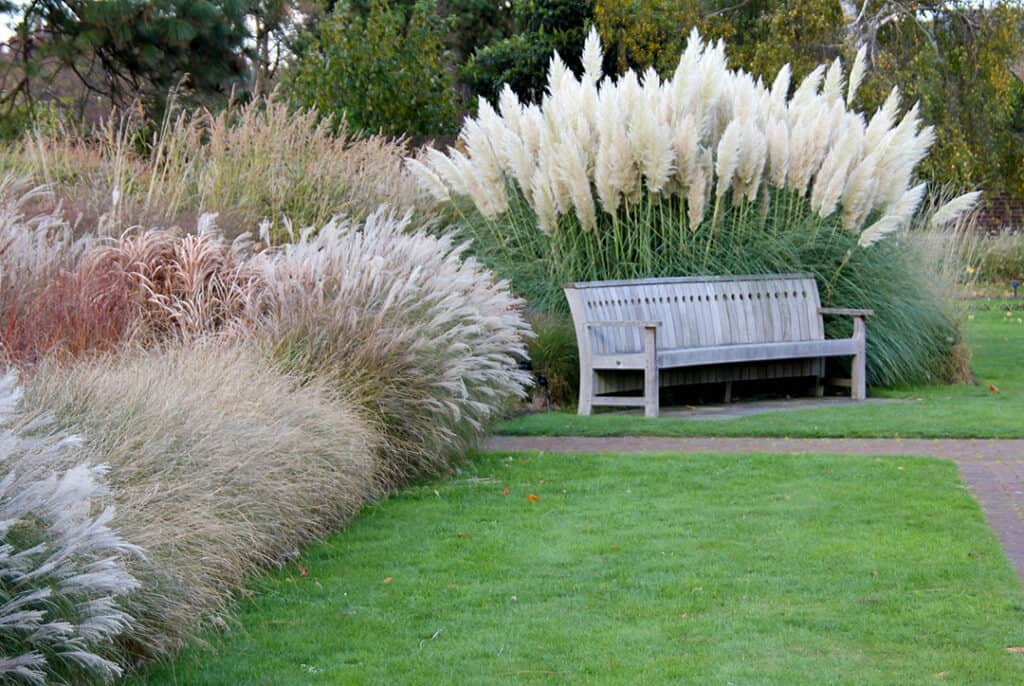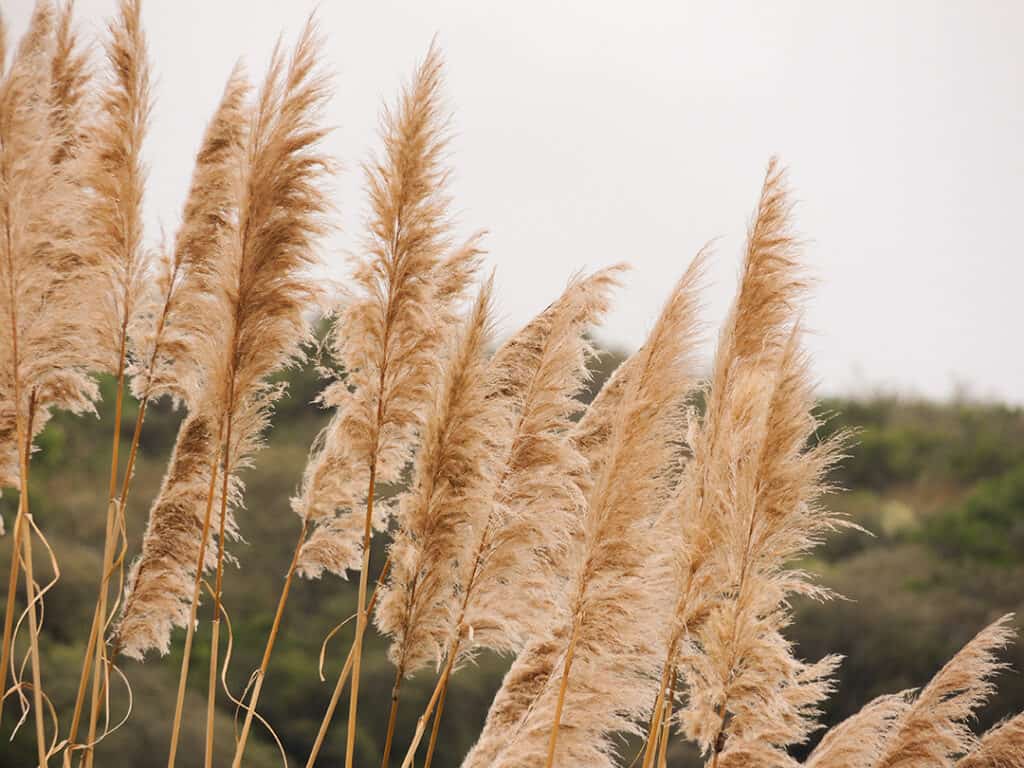Bring Movement and Texture to Your Landscape
Ornamental grasses bring texture to a garden (or pot) and movement as their leaves sway in passing breezes. They’re nothing like lawn grass, that needs mowing to be the green carpet we desire around our homes. Ornamental grasses are wonderful in a bed by themselves, on a berm, alongside a driveway or incorporated into an informal bed or border. Now that deer seem to be everywhere, roaming our village streets and gardens, eating more and more plants they didn’t before, so far (fingers crossed) they haven’t taken a liking to ornamental grasses. We have frequent deer on our property (this spring I came outdoors one morning to find a tiny baby fawn lying in the driveway next to my car. When I called the Evelyn Alexander Wildlife Rescue Center (who do heroic work saving and rehabilitating all sorts of wildlife; please support their work if you don’t already) I was assured that it was the time for baby deer to be born and that the mother would come back for it. I checked periodically and the baby was still there — but moved to the shady side of my car to get out of the sun. But after a few hours (long ones, I was worried) the mother did come back — I was lucky enough to look out the window at the right time and saw them leave together.

That said, because construction has taken over much of their habitat, deer are eating more and more plants from our gardens that they didn’t use to eat. Ornamental grasses, though, have not been on their menu. The ones on my deer-happy property have not been touched. (My vegetable and herb garden is enclosed in a high fence however.)
Ornamental grasses are super easy to care for. They adapt to different soils, they don’t need much in the way of fertilizing and watering (unless they’re in pots) and they lend texture to the garden all summer long.
When they bloom in late summer and fall, their “flowers” — actually seed heads — bring their texture and movement to the landscape. Just cut them back once a year, in late fall or early next spring.
Grasses are widely available in local nurseries and garden centers. Most grasses love the sun, but some of them will thrive with some shade, too.
Here are some ornamental grasses to consider for your garden or planters:
Foxtail grass (Alopecurus) The cylindrical flowers of this perennial grass inspired its name. One variety, Aureus, has golden yellow leaves. Plants grow to 2 feet high and do well in full sun to light shade.
Feather grass (Calamagrostis) This perennial produces upright tufts of narrow pale green leaves about a foot long. In late summer their attractive feathery, pale purple flowers can be used fresh or dried in arrangements.
Pampas grass (Cortaderia sellonana) There are many varieties of pampas grass in a range of sizes from 6 to 8 feet high, and varieties in green and gold banded leaves, as well as a dwarf variety that’s up to 5 feet high.

Miscanthus, aka silver grass, is probably the best known and most widely grown ornamental grass. There are many species and varieties with different textures and leaf coloring; leaves can be variegated combinations of green and gold, or silvery white, banded or streaked. Plants can range in size from 4 to 7 feet, and some are 8 feet or higher and great as a backdrop. See what your local nurseries have or plan ahead for next year!
Pennisteum, better known as foxtail grass for the shape of their “flowers” (seed heads), described as bottlebrush in horticultural circles (for the brushes once used to clean baby bottles). They can be buff-colored, creamy white or pinkish; one variety has “flowers” of deep brown to black.










![Reserve your ad space today in the upcoming Presidents Day Issue of #HRES 🇺🇸🗞️ Reach luxury buyers and sellers across the Hamptons, Manhattan, and South Florida with premium print distribution + global online exposure. Don’t wait—secure your spot now and make your brand unforgettable this season! [link in bio]](https://hamptonsrealestateshowcase.com/wp-content/uploads/sb-instagram-feed-images/474212416_493005373434932_760434066632157680_nfull.webp)

![Sotheby’s International Realty invites you to an exclusive Open House tour this weekend. Discover a unique selection of properties and uncover your one-of-a-kind home. [link in bio]](https://hamptonsrealestateshowcase.com/wp-content/uploads/sb-instagram-feed-images/474174381_918023810493820_1414728542535871428_nfull.webp)
![Paul Newman and Joanne Woodward’s iconic Manhattan penthouse at 1120 Fifth Ave. is under contract after less than three weeks on the market. The Hollywood legends purchased the prewar home in the early 1980s. Featuring two terraces totaling 2,300± sq. ft. with breathtaking Central Park views, the penthouse hosted glamorous parties for stars like Tom Cruise and Cher and even Presidents Clinton and Obama. [link in bio]](https://hamptonsrealestateshowcase.com/wp-content/uploads/sb-instagram-feed-images/474121000_1589891602257762_6316047342266079719_nfull.webp)
![The open and bright interior at 218 Dune Road features a gourmet eat-in kitchen with top-of-the-line appliances, living room with cozy fireplace, family room, and den/office. Each room showcases the spectacular vistas with walls of windows and sliding glass doors leading to decks and balconies. Represented by @westhamptonbroker of @brownharrisstevens. [link in bio]](https://hamptonsrealestateshowcase.com/wp-content/uploads/sb-instagram-feed-images/473764239_18486614449030135_9169863644392217853_nfull.webp)
![This exquisite bayfront shingle-style residence, meticulously crafted in 2014 by esteemed architect Craig Arm and master builder J.P. Spano, embodies unparalleled quality and elegance. Set on approximately 1.6± pristine acres in the exclusive enclave of Remsenburg, 46 Club Lane spans 9,000± sq. ft. of opulent living space. Represented by @theenzomorabito of @douglaselliman. [link in bio]](https://hamptonsrealestateshowcase.com/wp-content/uploads/sb-instagram-feed-images/473828596_18486469495030135_3335991097046992426_nfull.webp)
![134 Kellis Pond Lane is modern new construction that offers 3 levels of interior space totaling 10,850± sq. ft., a 1,400± sq. ft. roof deck, reserve across the street, and pond views to the East. The 20-room home features every amenity: 9 bedrooms, an office, gym, game room, theater, heated garage and two structure pool/guest house (one with office, one with lounge). Represented by @dawnbodenchak and @brucebaranoff of @sothebysrealty. [link in bio]](https://hamptonsrealestateshowcase.com/wp-content/uploads/sb-instagram-feed-images/473789420_18486427501030135_1408697563460710985_nfull.webp)
![@palmhousehotel_ is a luxurious modern 79-room hotel just mere steps from the Atlantic Ocean and ritzy Worth Avenue. It’s Palm Beach’s first new hotel in four years and highlights include an intimate dining room and bar, pool deck, sprawling suites, and a pink-and-green aesthetic all its own. [link in bio]](https://hamptonsrealestateshowcase.com/wp-content/uploads/sb-instagram-feed-images/473064779_583909624803181_7882225745991892474_nfull.webp)
